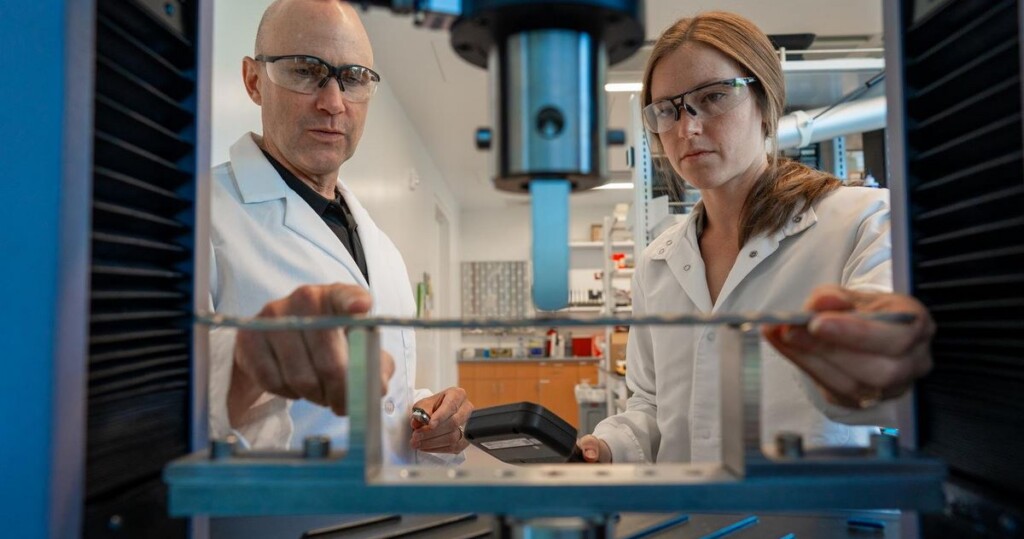
Scientists have invented a set of tiny sensors that can help tailor rehabilitation programs for people recovering from fractures.
Proper rehabilitation is essential to ensure the natural repair process occurs successfully, and the devices provided crucial feedback that accelerated this process in laboratory rats, allowing them to recover from femur fractures months earlier than expected.
Developed by researchers at the University of Oregon, the sensors transmit real-time data about what’s happening at the site of an injury after being implanted in the body.
The team says the sensors would allow doctors to monitor a patient’s progress and adjust exercises along the way to ensure they get the right amount of exercise.
They used this technology in a study published in the journal NPJ Regenerative Medicine, to show that a resistance training rehabilitation program can “significantly improve” femur injuries in rats in just eight weeks. Most femoral fractures take about four to six months to fully heal.
“Our data support early resistance rehabilitation as a promising treatment to increase bone formation, bone healing strength, and promote full restoration of mechanical properties to pre-injury levels,” said lead author of the study. study, Professor Bob Guldberg.
It has long been known that post-injury exercise follows a Goldilocks principle: too little or too much can hinder recovery, while enough can improve healing. However, it can be difficult to determine the exact type and intensity of exercise needed for best recovery, especially since it varies from patient to patient and bone to bone.
For their study, the researchers aimed to test whether resistance running, a specific type of recovery exercise, could provide the appropriate mechanical stimulation to improve bone recovery.
To do this, they built custom brakes for the rodent exercise wheels, which added resistance similar to that of increasing the level on an elliptical machine or stationary bike.
Rats with femur injuries and implanted sensors then ran on either a regular exercise wheel or the modified resistance exercise wheel.
The sensors transmitted strain data throughout the exercises, providing the research team with insight into the mechanical environment of bone cells during recovery.
During the eight-week study, researchers monitored the healing process of injured femurs and found that resistance-trained rats showed earlier signs of bone healing compared to those in sedentary or non-resistance conditions.
MORE STORIES LIKE THIS: New $1 test using origami paper sensors can detect infectious diseases like Covid – with just a cell phone
At the end of the eight-week recovery period, the sedentary, non-resistance, and resistance-trained mice showed bone healing, but the resistance-trained animals had denser tissue, indicating that resistance rehabilitation improved bone healing. bone formation.
In fact, injured bones from resistance-trained rats had mechanical properties, such as torque and stiffness, comparable to those of uninjured bones, which Guldberg says indicates that resistance training improves recovery, even without additional medications or biological stimulants.
EXERCISE TERMS: Visiting the gym today could trigger a brilliant idea next week, new study suggests
“One of the most exciting aspects of this work is that our resistance rehabilitation could regenerate the femur to normal strength in eight weeks without biological stimulants, and we are really excited about that,” said lead Dr. Kylie Williams. of the study.
Although the research was conducted on rodents, the team hopes that data-driven rehabilitation can also be used to improve recovery in human patients with musculoskeletal injuries.
MORE REMARKABLE BIOTECH: British boy receives brain implant to control epileptic seizures, world first
To achieve this goal, Penderia Technologies, a campus startup, is working on new improvements to implantable sensors, including a battery-free design and wearable monitors to facilitate their use in human patients.
“We hope that this work can one day be translated into the clinical setting, where these sensors can capture personalized measurements that take into account the type and severity of injuries to best inform rehabilitation decisions,” Guldberg concluded.
Announce the news of this new biotechnological invention with your friends on social networks…
